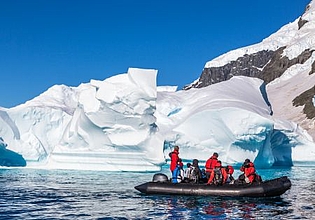Topic in Focus
Climate protection – why it is necessary and how it can succeed

Image: Adobe Stock | Vadim Nefedov
Earth’s climate was stable for a long time in the past 10,000 years. Since the start of industrialisation, the global average temperature has increased in a short time by more than 1°C due to the burning of fossil fuels and changes to land use. Without intensive climate protection measures the average rise over the next decades could exceed 2°C. Climate research contributes to the knowledge about our changing planet in the form of increasingly accurate climate models and possible solutions.
For decades now scientists have been raising awareness about how the human lifestyle is drastically changing the climate and Earth and that it is vital we change course. Yet the carbon dioxide in the atmosphere continues to increase almost constantly, propelling global warming. According to data from the International Energy Agency, around 36 gigatonnes of carbon dioxide (CO2) were emitted in 2021 by burning fossil fuels and industrial processes worldwide. 50 years ago it was just 14 gigatonnes.
The global average surface temperature already increased by at least 1.2°C between 1880 and 2020. The global community is now aware of the danger. In 2015, binding targets in accordance with international laws were set at the 21st World Climate Conference in the form of the Paris Agreement. 195 countries pledged to limit the rise of the worldwide average temperature in comparison to the pre-industrial era (1850 to 1900) to significantly under 2°C, if possible to under 1.5°C.
It is possible to roughly estimate how much CO2 and other greenhouse gases humans can still release into the atmosphere worldwide to maintain this target. This is known as the greenhouse gas budget. Should this be exceeded, then targets will most likely not be achievable. In order to limit the temperature increase to 1.5°C, humanity – calculated from the beginning of 2020 – can only release another 400 gigatonnes (billion tonnes) of CO2 into the atmosphere; to limit the increase to a maximum of 2°C, some 1,150 gigatonnes. The later we begin to limit emissions, the more drastic the measures will have to be to achieve the temperature target.
"The ice on our planet is melting at a breathtaking pace. And this is because many of the regions in which we still have ice are warming up faster than the rest of the Earth. This has caused us to lose more than 30 billion tonnes of ice from the Earth in the last decades, both due to the reduction of the sea ice but also due to the loss of glaciers and ice in Greenland and Antarctica. And the effects of this are visible all over the world, for example via the sea level that continues to rise faster. The ice landscapes are of course significant for all people around the world. The basis of our existence directly and even indirectly depends on the cryosphere, i.e. all of Earth’s ice landscapes. " Image: PIK / Karkow
At the 26th World Climate Conference in 2021 in Glasgow, Scotland, the groundwork for the implementation of the Paris Agreement was ratified in its entirety, thus beginning the phase in which countries must show that they actually do intend to implement the Agreement. By 2030, for the 1.5°C target, global CO2 emissions must sink by 45 percent compared to 2010. By 2050, net zero emissions should be achieved. “Net zero” means that humanity does not emit more greenhouse gases than natural sinks such as oceans or forests can absorb or that can be removed from the atmosphere using technology.
The targets are both clearly measurable and verifiable, and more concrete than before. Further, they clearly show how closely protecting the oceans, forests and other ecosystems is linked to climate protection. In addition, countries in the Global South, which have contributed the least to global warming yet will suffer the most from the consequences, have been approved financial support of more than 100 billion US dollars.
The Keeling Curve as a symbol of climate research
Knowledge regarding human-made climate change and the influence of greenhouse gases has developed over the last 200 years. In the 19th century, researchers identified initial links and discovered that Earth’s atmosphere creates a greenhouse effect which keeps the planet at a higher temperature than expected.
Towards the mid-19th century carbon dioxide was identified as the trace gas causing this temperature increase by preventing the infrared radiation from leaving the earth. The number of installed weather stations increased worldwide during this time. It thus became possible to establish a global average, to track the temperature change on Earth and, with the later measurement of CO2 concentration, to make causal links. In the transition from the 19th to 20th century it became increasingly clear that rising amounts of CO2 in the atmosphere lead to increasing temperatures and that this can be caused by the burning of fossil fuels.
Yet it was only in 1958 that the continual measurement of CO2 concentration in the atmosphere began on the volcano Mauna Loa (Hawaii/USA, 3,397 metres above sea level). The first measurement revealed a concentration of 313 ppm (parts per million). In 2021 values over 420 ppm were recorded for the first time. The continual varying rise of CO2 concentration in the atmosphere over the years has become a symbol of climate research in the form of the so-called Keeling Curve. It graphically represents the average concentration change of CO2 in the earth’s atmosphere and is named after Charles Keeling from the Scripps Institution of Oceanography in La Jolla, California, USA. The climate researcher, who passed away in 2005, initiated the building of measurement stations (and other stations), recorded data over decades and thus for the first time found convincing proof that humans influence the CO2 concentration in the earth’s atmosphere by burning fossil fuels.
„We assume that we want to achieve the 2°C target. And we can calculate how large the concentration of carbon dioxide in the atmosphere can be if we want to achieve that target. It’s around 430 ppm. Today there is approximately 410 ppm in the atmosphere. This means we can calculate how many million tonnes of carbon can still be burned before this difference of 25 to 30 ppm is reached. That is between 600 and 800 gigatonnes. It sounds enormous. But when we consider that we currently blast 35 gigatonnes into the atmosphere every year anyway, then we can conclude that the budget will largely be exhausted in 20 years. It will be used up in such a short time that we will have to act quicker than we are at the moment. The extrapolation of our current carbon saving will take us into the year 2100.“
From Club of Rome to Fridays for Future
Back in 1965 scientists warned a US president about climate change and its consequences for the first time. Charles Keeling was also part of the scientific advisory committee that brought the then president Lyndon B. Johnson’s attention to the significant environmental changes caused by an accumulation of carbon dioxide.
An influential organisation in this area was the Club of Rome, which published the first scientifically based report entitled “The Limits of Growth” in 1972. Although climate change was not one of the main topics, the publication brought the public’s attention to subjects such as resource exploitation, environmental destruction, and overpopulation, and appealed for a sustainable lifestyle in ecological and economic balance.
From the mid-20th century it became ever clearer that the earth’s atmosphere was continually warming due to human activity. In order to counteract this threat, the Environment Programme of the United Nations and the World Meteorological Organization (WMO) founded the IPCC in 1988, the Intergovernmental Panel on Climate Change, also known as the World Climate Council. It is the central scientific body in the global fight against global warming. The committee publishes, among other things, an assessment report every five to six years with a scientific estimate regarding the status quo of the global climate situation.
UN World Climate Conferences, officially called Conference of the Parties (COP) to the United Nations Framework Convention on Climate Change, have been taking place since 1995. Two of the most important outcomes in this context were the Kyoto Protocol in 1997 which came into force in 2005 and the Paris Agreement which was concluded in 2015 and replaced the Kyoto Protocol in 2016.
In 2019 the European Commission suggested the European Green Deal. It resulted in the 2021 European Climate Law, which stipulates that the EU member states will be climate neutral by 2050. By 2030, as part of this transition, net greenhouse gas emissions must be reduced by at least 55 percent in comparison to 1990.
„In Germany and Europe we have given ourselves a framework, the European Green Deal. It would really help us if we were to implement it. And if all countries would implement the agreed measures and targets as recently specified at the UN Climate Conference in Glasgow, then we would still be able to aim for the 1.5°C target. It is important that we continue to tell ourselves that there is a way, there are solutions, we just have to combine them. It is actually never too late to act. After all, the planet will not be dead if it becomes 1.5°C or 2°C warmer, it will just become more uncomfortable, more expensive, more conflict-ridden. And that is not the future we wish for ourselves. So it is this path, the one we have already decided on politically, that we must follow, with courage and lots of ambition.“ Imgae: Esther Horvath
„Ultimately we will only be able to solve our climate and environment issues by means of government action and frameworks. The big question is always, what is the scope of government action? Does it only define the framework and allow for many individual freedoms or does it get involved intensively? The European Green Deal is, in my view, primarily a comprehensive narrative by the EU Commission to ensure growth and progression in the EU with the concept it is pursuing. It is an attempt to find a narrative as to how prosperity, well-being, growth and environmental protection can be combined. The overall goal is climate neutrality: The continent aims to be climate neutral by the middle of the century.“ Image: RWI / Sven Lorenz
Aside from institutional facilities, independent movements and initiatives have developed over the past years that regularly raise awareness of the climate crisis via demonstrations and campaigns to stir politics and society into action. The Fridays for Future movement is especially well-known. It began when Swedish student Greta Thunberg went on her first school strike for the climate on 20 August 2018 and quickly grew into a global movement.
What is to be done?
Efforts to reduce the concentration of CO2 and other greenhouse gases can be focused on three approaches. The first and most important approach is the fast and sustainable departure from fossil fuels. This ultimately requires a fundamental transformation of energy conversion worldwide so that industry and society can completely cease burning fossil fuels.
The second approach is based on protecting and expanding natural carbon sinks. Around half of the emissions caused by humans have been absorbed by forests, soils and the oceans. It is uncertain as to how long soils and forests can maintain this, so it is important that we protect these sinks. A third approach consists in the use of technological measures to create so-called negative emissions in which CO2 is removed from the atmosphere. Many of these processes have however only been tested locally and it is unclear how practical they are on a global scale.
Published: August 2022






